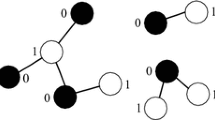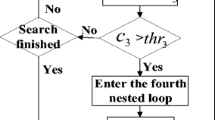Abstract
The extensive use of Voice over IP (VoIP) applications makes low bit-rate speech stream a very suitable steganographic cover media. To incorporate steganography into low bit-rate speech codec, we propose a novel approach to embed information during linear predictive coding (LPC) process based on Matrix Embedding (ME). In the proposed method, a mapping table is constructed based on the criterion of minimum distance of Linear-Predictive-Coefficient-Vectors, and embedding position and template are selected according to a private key so as to choose the cover frames. The original speech data of the chosen frames are partially encoded to get the codewords for embedding and then the codewords that need to be modified for embedding are selected according to the secret bits and ME algorithm. The selected codeword will be changed into its best replacement codeword according to the mapping table. When embedding k (k > 1) bits into 2k−1 codewords, the embedding efficiency of our method is k times as that of LPC-based Quantization Index Modulation method. The performance of the proposed approach is evaluated in two aspects: distortion in speech quality introduced by embedding and security under steganalysis. The experimental results demonstrate that the proposed approach leads to a better performance with less speech distortion and better security.










Similar content being viewed by others
References
Chang YT, Huang CT, Huang CL, Wang SJ (2014) Data hiding of high compression ratio in VQ indices with neighboring correlations. Multimed Tools Appl 74(5):1645–1666
Chen B, Wornell GW (2001) Quantization index modulation: a class of provably good methods for digital watermarking and information embedding. IEEE T Inform Theory 47(4):1423–1443
Chiang Y-K, Tsai P, Huang F-L (2008) Codebook partition based steganography without member restriction. Fundam Inform 82(1-2):15–27
Crandall R (1998) Some notes on steganography. Available: http://os.inf.tu-dresden.de/~westfeld/crandall.pdf. Accessed 1 May 2015
Girl (2008) Available: http://en.wikipedia.org/wiki/Girl. Accessed 1 May 2015
Huang YF, Liu CH, Tang SY, Bai S (2012) Steganography integration into a low-bit rate speech codec. IEEE T Inf Foren Sec 7(6):1865–1875
Huang YF, Tang S, Yuan J (2011) Steganography in inactive frames of VoIP streams encoded by source codec. IEEE T Inf Foren Sec 6(2):296–306
Hui T, Ke Z, Hong J, Jin L, Yongfeng H, Dan F (2009) An M-Sequence Based Steganography Model for Voice over IP. In: IEEE International Conference on Communications, 2009. ICC ’09. IEEE, pp 1–5
Ito A, Abe S, Suzuki Y (2009) Information hiding for G.711 speech based on substitution of least significant bits and estimation of tolerable distortion. In: IEEE International Conference on Acoustics, Speech and Signal Processing, 2009. IEEE, pp 1409–1412
ITU-T G.729 (1996) Coding of speech at 8 kbits/s using conjugate-structure algebraic-code-excited linear prediction (CS-ACELP). International Telecommunications Union, Geneva, Switzerland
Jin L, Ke Z, Hui T (2012) Least-significant-digit steganography in low bitrate speech. In: IEEE International Conference on Communications (ICC), 2012. IEEE, pp 1133–1137
Lee JD, Chiou YH, Guo JM (2013) Lossless data hiding for VQ indices based on neighboring correlation. Inform Sci 221(2):419–438
Li SB, Tao HZ, Huang YF (2012) Detection of quantization index modulation steganography in G.723.1 bit stream based on quantization index sequence analysis. J Zhejiang Univ-SC C 13(8):624–634
Lin C, Pan JS, Liao BY (2006) Robust VQ-based digital image watermarking for mobile wireless channel. In: Proceedings of the 2006 IEEE International Conference on Systems, Man and Cybernetics. IEEE, pp 2380–2384
Liu L, Li M, Li Q, Liang Y (2008) Perceptually transparent information hiding in G. 729 bitstream. In: 2008 International Conference on Intelligent Information Hiding and Multimedia Signal Processing. IEEE, pp 406–409
Lu ZM, Yan B, Sun SH (2005) Watermarking combined with CELP speech coding for authentication. Ieice T Inf Syst E88-D (2):330–334
Qin C, Chang CC, Chen YC (2013) Efficient reversible data hiding for VQ-compressed images based on index mapping mechanism. Signal Process 93 (9):2687–2695
Qingzhong L, Sung AH, Mengyu Q (2009) Temporal derivative-based spectrum and Mel-Cepstrum audio Steganalysis. IEEE T Inf Foren Sec 4(3):359–368
Rahmani P, Dastghaibyfard G (2014) A low distortion reversible data hiding scheme for search order coding of VQ indices. Multimed Tools Appl:1–22
Recommendation P.563 Erratum 1 (2007) http://www.itu.int/rec/T-REC-P.563-200710-I!Err1/en. Accessed 15 August 2015
Recommendation P.800 (1996) http://www.itu.int/rec/T-REC-P.800-199608-I/en. Accessed 15 August 2015
Recommendation P.862 (2001) http://www.itu.int/rec/T-REC-P.862-200102-I/en. Accessed 15 August 2015
Roselinkiruba R, Balakirshnan R (2013) Secure steganography in audio using inactive frames of VoIP streams. In: IEEE Conference on Information & Communication Technologies (ICT), 2013. IEEE, pp 491–495
Simmons G (1984) The prisoners problem and the subliminal channel. In: Chaum D (ed) Advances in Cryptology. Springer US, pp 51–67
Simmons G (1985) The subliminal channel and digital signatures. In: Beth T, Cot N, Ingemarsson I (eds) Advances in Cryptology, vol 209. Lecture Notes in Computer Science. Springer Berlin Heidelberg, pp 364–378
Simmons GJ (1994) Subliminal channels - past and present. Eur T Telecommun 5(4):459–473
TeleGeography Report & Database (2014) Available: https://www.telegeography.com/research-services/telegeography-report-database/index.html Accessed 15 August 2015
Tingting X, Zhen Y (2009) Simple and effective speech steganography in G.723.1 low-rate codes. In: WCSP ’09 International Conference on Wireless Communications & Signal Processing, 2009. IEEE, pp 1–4
Tutte WT (2001) Graph theory. Cambridge University Press, pp 233–237
Wang FH, Jain LC, Pan JS (2007) VQ-based watermarking scheme with genetic codebook partition. J Netw Comput Appl 30(1):4–23
Westfeld A (2001) F5A Steganographic Algorithm. In: Moskowitz I (ed) Information Hiding, vol 2137. Lecture Notes in Computer Science. Springer Berlin Heidelberg, pp 289–302
Xiao B, Huang Y, Tang S (2008) An approach to information hiding in low bit-rate speech stream. In: Global Telecommunications Conference. IEEE, pp 1–5
Yan S, Tang G, Sun Y, Gao Z, Shen L (2014) A triple-layer steganography scheme for low bit-rate speech streams. Multimed Tools Appl:1–20
Acknowledgments
This work is supported partly by Natural Science Foundation of Nation and Hainan Province of China under grant 61303249 and 614236, and partly by Important Science & Technology Project of Hainan Province of China under grant JDJS2013006 and ZDXM2015103, and partly by Preferred Foundation of Director of Institute of Acoustics, Chinese Academy of Sciences, and partly by the Young Talent Frontier Project of Institute of Acoustics, Chinese Academy of Sciences.
Author information
Authors and Affiliations
Corresponding author
Rights and permissions
About this article
Cite this article
Liu, P., Li, S. & Wang, H. Steganography integrated into linear predictive coding for low bit-rate speech codec. Multimed Tools Appl 76, 2837–2859 (2017). https://doi.org/10.1007/s11042-016-3257-x
Received:
Revised:
Accepted:
Published:
Issue Date:
DOI: https://doi.org/10.1007/s11042-016-3257-x




